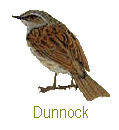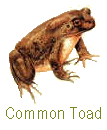Menu
Fauna
General
The diverse vegetation and habitats on Bramcote Ridge (as detailed on the Flora page create a myriad of 'micro habitats' that provide a wealth of wildlife with the specific conditions required for food shelter and breeding sites.
 A casual visit to the Ridge will reveal birds as the most conspicuous wildlife in the area, due to their continual movement and/or song. They can be observed throughout the site, sometimes at quite close quarters especially in the wooded areas. Over 50 species have been recorded in the area over recent years, but due to their migratory nature not all will be present at any one time.
A casual visit to the Ridge will reveal birds as the most conspicuous wildlife in the area, due to their continual movement and/or song. They can be observed throughout the site, sometimes at quite close quarters especially in the wooded areas. Over 50 species have been recorded in the area over recent years, but due to their migratory nature not all will be present at any one time.
 But looking a little closer will also reveal an even greater wealth of invertebrates. Butterflies can be seen in the open grassland areas, dragonflies and damselflies flit about near the scrub and woodland edges and many other flying insects can be observed feeding on the open flowers.
But looking a little closer will also reveal an even greater wealth of invertebrates. Butterflies can be seen in the open grassland areas, dragonflies and damselflies flit about near the scrub and woodland edges and many other flying insects can be observed feeding on the open flowers.
Looking more closely amongst the vegetation will reveal ants, beetles, molluscs, spiders and caterpillars, all busy hunting or feeding.
Even under the leaf litter, in the soil and under fallen or dead branches these is a wealth of different species of small invertebrates to be observed.
 More difficult to sight are the mammals that inhabit the area, although there are plenty of signs of their presence. 'Tell-tales' such as noises in the undergrowth, droppings, nibbled food or piles of feathers all denote the presence of specific species.
More difficult to sight are the mammals that inhabit the area, although there are plenty of signs of their presence. 'Tell-tales' such as noises in the undergrowth, droppings, nibbled food or piles of feathers all denote the presence of specific species.
Grey Squirrels are the most noticeable as they are active throughout the year and can be frequently observed in the woodland performing acrobatics between the trees.
Many of the other mammals that are present on the Ridge, such as Fox, Hedgehog and visiting Badger, are predominately nocturnal and are seldom seen. Although foxes can sometimes be spotted during the day and late evening in summer - which is also the best time to bats flitting across the darkening sky.
 Although the sandy soils make the site very dry, amphibians such as Common Frog and Toad are also present throughout the site, usually deep within the undergrowth searching for invertebrates. We assume that they migrate onto the site from ponds in the surrounding gardens, as there is no other wetland habitats in the general area.
Although the sandy soils make the site very dry, amphibians such as Common Frog and Toad are also present throughout the site, usually deep within the undergrowth searching for invertebrates. We assume that they migrate onto the site from ponds in the surrounding gardens, as there is no other wetland habitats in the general area.
Usually the best opportunity to see them is by helping with the Friend's habitat management.
Management of wildlife is extremely difficult to implement successfully as individual species form complex inter-relationships with both vegetation and other faunal species (predator/prey). The deliberate intervention in the population size of one species (however 'insignificant' it may seem) may seriously affect the viability of other dependent species in the complex food web.

A Simplified Woodland Food Web
Since all animal life is ultimately dependant on the vegetation within an area, the best management practice is always to ensure that the widest possible diversity of vegetation and habitats are available for wildlife to exploit. This can only be achieved by continual sensitive management.
|
For a listings of animals recorded on the site to-date use the links above |
Vertebrate Species List
This page lists all the Mammal, Bird and Amphibian species identified on the entire open space. Each species is categorised with both its common and scientific name, along with a 'frequency' intended to give some indication as to how widespread each species is on the site - i.e. common or scarce resident, summer or winter visitor.
|
If the Common Name is GREEN, this signifies that there is a photograph of that species in our library: click the link to view the relevant photo and click anywhere image to close it. |
Mammals |
||
|
Common Name |
Scientific Name |
Frequency |
|
Field (Wood) Mouse |
Apodemus sylvaticus |
common resident |
|
Field Vole |
Microtus agrestis |
scarce resident |
|
Brown Rat |
Rattus norvegious |
scarce resident |
|
Common Shrew |
Sorex araneus |
scarce resident |
|
Talpa europaea |
common resident |
|
|
Erinaceus europaeus |
scarce resident |
|
|
Sciurus carolinensis |
abundant resident |
|
|
Badger |
Meles meles |
non resident |
|
Vulpes vulpes |
scarce resident |
|
Birds |
||
|
Common Name |
Scientific Name |
Frequency |
|
Mallard ² |
Anas platyrhynchos |
scarce resident |
|
Buzzard |
Buteo buteo |
scarce resident |
|
Accipiter nisus |
fairly common resident |
|
|
Kestrel ² |
Falco tinnunculus |
scarce resident |
|
Pheasant |
Phasianus colchicus |
scarce resident |
|
Woodcock ¹ |
Scolopax rusticola |
scarce resident |
|
Black-Headed Gull ² |
Chroicocephalus ridibundas |
scarce resident |
|
Stock Dove ² |
Columba oenas |
scarce resident |
|
Woodpigeon |
Columba palumbus |
abundant resident |
|
Collared Dove |
Streptopelia decaocto |
common resident |
|
Tawny Owl ² |
Strix aluco |
scarce resident |
|
Swift ² |
Apus apus |
common summer visitor |
|
Rose Ringed Parakeet |
Psittacula krameri |
rare visitor |
|
Picus viridis |
fairly common resident |
|
|
Dendrocopos major |
fairly common resident |
|
|
Lesser Spotted Woodpecker ¹ |
Dendrocopos minor |
rare resident |
|
Swallow |
Hirundo rustica |
fairly common summer visitor |
|
House Martin ² |
Delichon urbica |
fairly common summer visitor |
|
Pied Wagtail |
Motcilla alba |
scarce resident |
|
Waxwing |
Bombycilla garrulus |
scarce winter visitor |
|
Dunnock ² |
Prunella modularis |
common resident |
|
Whitethroat |
Sylvia communis |
scarce summer visitor |
|
Lesser Whitethroat |
Sylvia curruca |
scarce summer visitor |
|
Blackcap ³ |
Sylvia atricapilla |
common summer/winter visitor |
|
Phylloscopus trochilus |
scarce summer visitor |
|
|
Chiffchaff |
Phylloscopus collybita |
fairly common summer visitor |
|
Wood Warbler ¹ |
Phylloscopus sibilatrix |
scarce summer visitor |
|
Garden Warbler |
Silvia borin |
scarce summer visitor |
|
Goldcrest |
Regulus regulus |
scarce resident |
|
Robin |
Erithacus rubecula |
common resident |
|
Blackbird |
Turdus merula |
abundant resident |
|
Fieldfare ¹ |
Turdus pilaris |
fairly common winter visitor |
|
Redwing ¹ |
Turdus iliacus |
fairly common winter visitor |
|
Song Thrush ¹ |
Turdus philomelos |
scarce resident |
|
Mistle Thrush ¹ |
Turdus viscivorus |
scarce resident |
|
Aegithalos caudatus |
common resident |
|
|
Parus ater |
fairly common resident |
|
|
Parus major |
common resident |
|
|
Parus caeruleus |
common resident |
|
|
Nuthatch |
Sitta europaea |
fairly common resident |
|
Treecreeper |
Certhia familiaris |
scarce resident |
|
Wren |
Troglodytes troglodytes |
common resident |
|
Fringilla coelebus |
common resident |
|
|
Goldfinch |
Carduelis carduelis |
common resident |
|
Siskin |
Carduelis spinus |
scarce winter visitor |
|
Greenfinch |
Carduelis chloris |
common resident |
|
Bullfinch ² |
Pyrrhula pyrrhula |
fairly common resident |
|
Common Redpoll ² |
Carduelis flammea |
scarce winter visitor |
|
House Sparrow ¹ |
Passer domesticus |
scarce resident |
|
Starling ¹ |
Sturnus vulgaris |
scarce resident |
|
Garrulus glandarius |
fairly common resident |
|
|
Magpie |
Pica pica |
abundant resident |
|
Carrion Crow |
Corvus corone corone |
common resident |
|
Jackdaw |
Corvus monedula |
fairly common resident |
| ¹ Species on the BTO/RSPB/JNCC Red List (of HIGH Conservation Concern) updated in 2015 | ||
| ² Species on the BTO/RSPB/JNCC Amber List (of MODERATE Conservation Concern) updated in 2015 | ||
| ³ The Blackcap is not considered as a resident: Those seen during summer migrate further south in winter, and those seen during winter were living further north during the summer months. | ||
Amphibians |
||
|
Common Name |
Scientific Name |
Frequency |
|
Common Toad |
Buffo buffo |
scarce resident |
|
Common Frog |
Rana temporaria |
scarce resident |
Invertebrate Species List
This page lists all the Bee, Butterfly, Damselfly and Dragonfly species identified on the entire open space. Hopefully this list will grow over time as other species are recorded.
It is also hoped that more invertebrates species will be included on these pages at some point in the future. Unfortunately these call for specialist survey techniques, and so, may take some time to organise and implement.
Each species is categorised with both its common and scientific name, along with a 'frequency' intended to give some indication as to how widespread each species is on the site - i.e. common or scarce resident, summer or winter visitor.